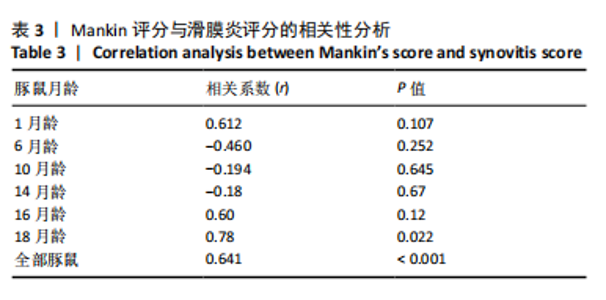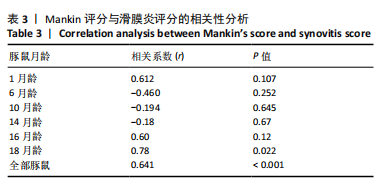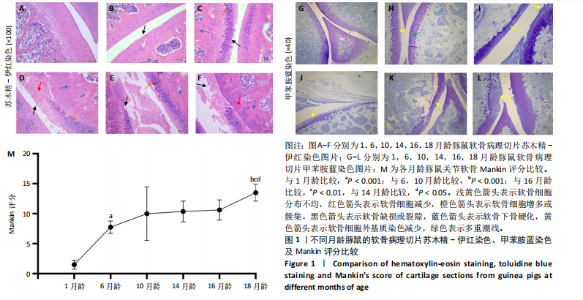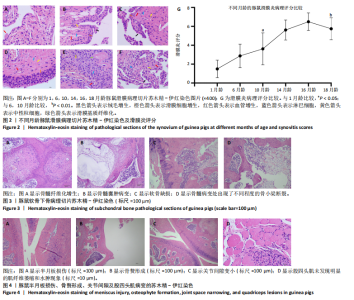[1] PIGEOLET M, JAYARAM A, PARK KB, et al. Osteoarthritis in 2020 and beyond.Lancet. 2021;397(10279):1059-1060.
[2] SAFIRI S, KOLAHI A A, SMITH E, et al. Global, regional and national burden of osteoarthritis 1990-2017: A systematic analysis of the global burden of disease study 2017. Ann Rheum Dis. 2020;79(6):819-828.
[3] MARTEL-PELLETIER J, BARR A J, CICUTTINI FM, et al. Osteoarthritis. Nat Rev Dis Primers. 2016;2:16072.
[4] BANNURU RR, OSANI MC, VAYSBROT EE, et al. OARSI guidelines for the non-surgical management of knee, hip, and polyarticular osteoarthritis. Osteoarthritis Cartilage. 2019;27(11):1578-1589.
[5] KUYINU EL, NARAYANAN G, NAIR LS, et al. Animal models of osteoarthritis: classification, update, and measurement of outcomes. J Orthop Surg Res. 2016;11:19.
[6] COPE PJ, OURRADI K, LI Y, et al. Models of osteoarthritis: The good, the bad and the promising. Osteoarthritis Cartilage. 2019;27(2): 230-239.
[7] ZAKI S, BLAKER CL, LITTLE CB. OA foundations - experimental models of osteoarthritis. Osteoarthritis Cartilage. 2022;30(3):357-380.
[8] GREGORY MH, CAPITO N, KUROKI K, et al. A review of translational animal models for knee osteoarthritis. Arthritis. 2012;2012:764621.
[9] PRITZKER KP, GAY S, JIMENEZ SA, et al. Osteoarthritis cartilage histopathology: grading and staging. Osteoarthritis Cartilage. 2006; 14(1):13-29.
[10] MAKARCZYK MJ, GAO Q, HE Y, et al. Current Models for Development of Disease-Modifying Osteoarthritis Drugs. Tissue Eng Part C Methods. 2021;27(2):124-138.
[11] RAMOS-MUCCI L, JAVAHERI B, VAN ‘T HOF R, et al. Meniscal and ligament modifications in spontaneous and post-traumatic mouse models of osteoarthritis. Arthritis Res Ther. 2020;22(1):171.
[12] VERONESI F, SALAMANNA F, MARTINI L, et al. Naturally Occurring Osteoarthritis Features and Treatments: Systematic Review on the Aged Guinea Pig Model. Int J Mol Sci. 2022;23(13):7309.
[13] MUSCI RV, WALSH MA, KONOPKA AR, et al. The Dunkin Hartley Guinea Pig Is a Model of Primary Osteoarthritis That Also Exhibits Early Onset Myofiber Remodeling That Resembles Human Musculoskeletal Aging. Front Physiol. 2020;11:571372.
[14] YOSHIMURA N, MURAKI S, OKA H, et al. Accumulation of metabolic risk factors such as overweight, hypertension, dyslipidaemia, and impaired glucose tolerance raises the risk of occurrence and progression of knee osteoarthritis: A 3-year follow-up of the road study. Osteoarthritis Cartilage. 2012;20(11):1217-1226.
[15] HUNTER DJ, BIERMA-ZEINSTRA S. Osteoarthritis. Lancet. 2019; 393(10182):1745-1759.
[16] FELSON DT, NAIMARK A, ANDERSON J, et al. The prevalence of knee osteoarthritis in the elderly. The framingham osteoarthritis study. Arthritis Rheum. 1987;30(8):914-918.
[17] SOWERS M R, MCCONNELL D, JANNAUSCH M, et al. Estradiol and its metabolites and their association with knee osteoarthritis. Arthritis Rheum. 2006;54(8):2481-2487.
[18] BERENBAUM F, WALLACE IJ, LIEBERMAN DE, et al. Modern-day environmental factors in the pathogenesis of osteoarthritis. Nat Rev Rheumatol. 2018;14(11):674-681.
[19] HARASYMOWICZ NS, CLEMENT ND, AZFER A, et al. Regional differences between perisynovial and infrapatellar adipose tissue depots and their response to class ii and class iii obesity in patients with osteoarthritis. Arthritis Rheumatol. 2017;69(7):1396-1406.
[20] WANG S, MA J, ZHAO X, et al. The Osteoarthritis Natural Progress and Changes in Intraosseous Pressure of the Guinea Pig Model in Different Degeneration Stages. Orthop Surg. 2022;14(11):3036-3046.
[21] DIAMOND LE, GRANT T, UHLRICH SD. Osteoarthritis year in review 2023: Biomechanics. Osteoarthritis Cartilage. 2024;32(2):138-147.
[22] SELLAM J, BERENBAUM F. The role of synovitis in pathophysiology and clinical symptoms of osteoarthritis. Nat Rev Rheumatol. 2010; 6(11):625-635.
[23] KNIGHTS AJ, REDDING SJ, MAERZ T. Inflammation in osteoarthritis: the latest progress and ongoing challenges. Curr Opin Rheumatol. 2023;35(2):128-134.
[24] PRIMORAC D, MOLNAR V, ROD E, et al. Knee osteoarthritis: A review of pathogenesis and state-of-the-art non-operative therapeutic considerations. Genes (Basel). 2020;11(8):854.
[25] DRIBAN JB, TASSINARI A, LO GH, et al. Bone marrow lesions are associated with altered trabecular morphometry. Osteoarthritis Cartilage. 2012;20(12):1519-1526.
[26] HUNTER DJ, ZHANG YQ, NIU JB, et al. Increase in bone marrow lesions associated with cartilage loss: a longitudinal magnetic resonance imaging study of knee osteoarthritis.Arthritis Rheum. 2006;54(5): 1529-1535.
[27] YANG Y, LI P, ZHU S, et al. Comparison of early-stage changes of osteoarthritis in cartilage and subchondral bone between two different rat models. PeerJ. 2020;8:e8934.
[28] STEHLING C, SOUZA RB, HELLIO LE GRAVERAND MP, et al. Loading of the knee during 3.0t mri is associated with significantly increased medial meniscus extrusion in mild and moderate osteoarthritis. Eur J Radiol. 2012;81(8):1839-1845.
[29] KIM JR, YOO JJ, KIM HA. Therapeutics in osteoarthritis based on an understanding of its molecular pathogenesis. Int J Mol Sci. 2018; 19(3):674.
[30] KRISHNASAMY P, HALL M, ROBBINS SR. The role of skeletal muscle in the pathophysiology and management of knee osteoarthritis. Rheumatology (Oxford). 2018;57(suppl_4):iv22-iv33.
[31] 郭长青, 谢汶姗,郭长青. 电针穴位刺激对膝骨性关节炎兔股直肌的影响研究[J]. 世界中西医结合杂志,2020,15(8):1456-1460.
|





